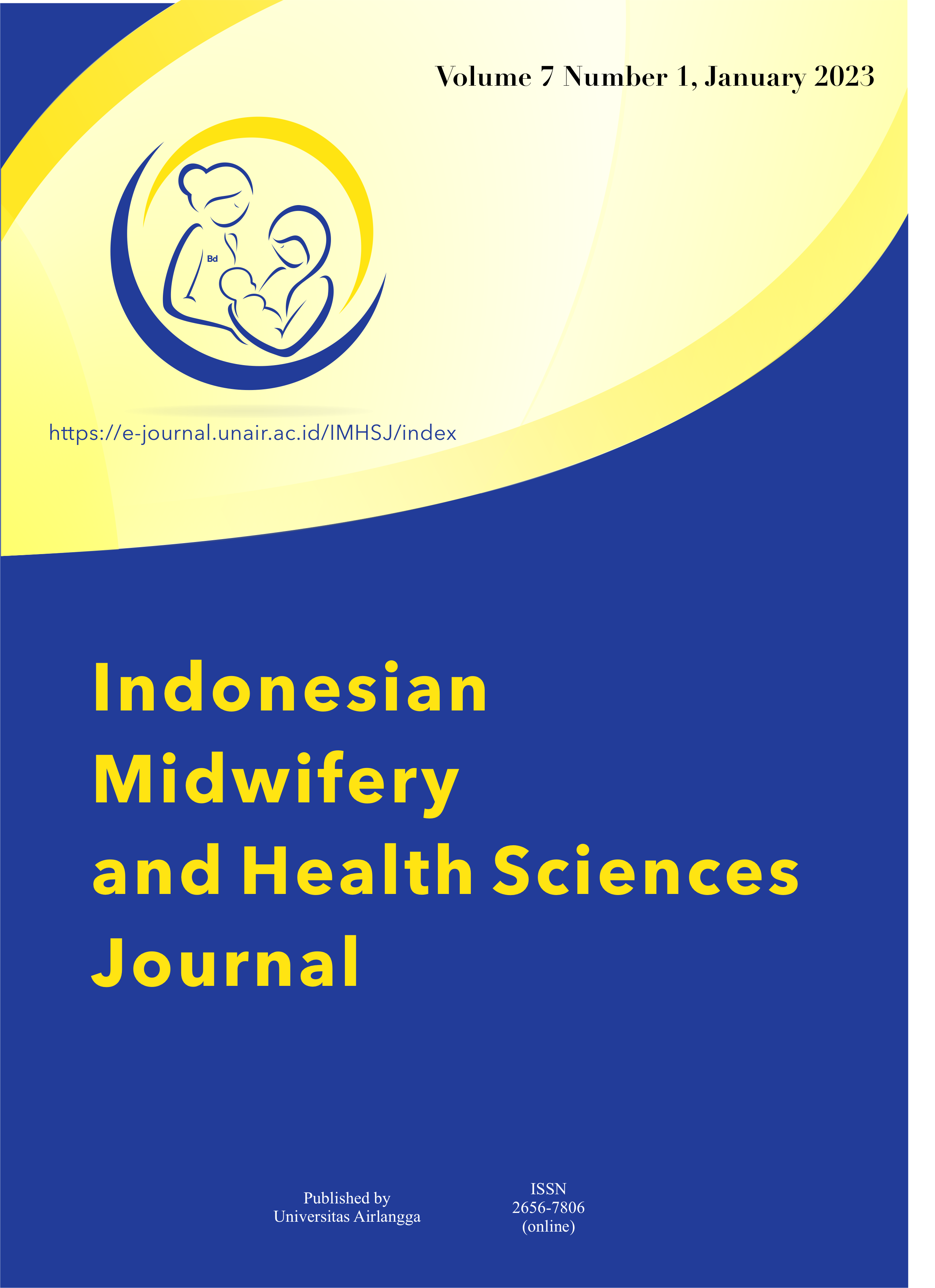RELATIONSHIP BETWEEN DURATION AND REGULARITY OF MENSTRUAL CYCLE WITH PRIMARY DYSMENORRHEA IN ADOLESCENTS

Downloads
Background: For women who have experienced menstruation, some common problems can occur such as pain during menstruation or disturbances in the menstrual cycle. The high prevalence of primary dysmenorrhea requires appropriate prevention and treatment efforts by recognizing the risk factors for primary dysmenorrhea, one of which is an abnormal menstrual cycle. Based on the existing literature, this study aims to examine the relationship between the length and regularity of the menstrual cycle with the incidence of primary dysmenorrhea. Method: This type of research is quantitative with cross sectional design. The minimum number of samples used is 57 people who are determined by the simple random sampling technique. The data collection instrument in this study was a questionnaire in the form of a Google form. The independent variables in this study were the length and regularity of menstrual cycle and the dependent variable was primary dysmenorrhea. The statistical tests used were Spearman Rank and Exact Fisher's Test with a significance value (P) = 0.05 to determine the level of significance of the research results. Results: Based on the results of the Spearman Rank statistical test, a significance value of 0.3 was obtained where the value of Sig.(2-tailed) > 0.05, so it was concluded that there was no relationship between the length of the menstrual cycle and the incidence of primary dysmenorrhea. The results of the Exact Fisher's Test obtained a significance value of 0.034 where the value of Sig.(2-sided) <0.05, it was concluded that there was a significant relationship between the regularity of the menstrual cycle and the incidence of primary dysmenorrhea. Conclusion: There is no relationship between the length of the menstrual cycle and the incidence of primary dysmenorrhea and there is a relationship between the regularity of the menstrual cycle and the incidence of primary dysmenorrhea.
Key words : menstrual cycle, primary dysmenorrhea, adolescents
Al-Matouq, S., Al-Mutaini, H., Al-Mutaini, O., Abdulaziz, A., Al-Basri D., Al-Enzi, M. dan Al-Taiar, A. (2019) ‘Dysmenorrhea among high-school students and its associated factors in Kuwait', BMC Pediatrics, 19(1), pp. 1–12. doi: 10.1186/s12887-019-1442-6.
Bernardi M, Lazzeri L, Perelli F, Reis FM, Petraglia F. Dysmenorrhea and related disorders. F1000Res. (2017) Sep 5;6:1645. doi: 10.12688/f1000research.11682.1. PMID: 28944048; PMCID: PMC5585876.
Bezuidenhout, S., Mahlaba, K. J., Nxumalo, G., Meyer, J. C. dan Chukwu, B. O. (2018) ‘Dysmenorrhea: an overview', SA Pharmaceutical Journal, 85(4), pp. 19 – 25.
Dayalan V, Rajavelu S, Kumari S, et al. (2017). ‘A study on menstrual health in school going adolescent girls from South India', J. Evid Based Med Healthc, 4(77), pp 3239 – 3244. doi: 10.18410/jebmh/2017/910
Hailemeskel S, Demissie A, Assefa N. (2016) ‘Primary dysmenorrhea magnitude, associated risk factors, and its effect on academic performance: evidence from female university students in Ethiopia'. Int J Womens Health, 8: 489– 496.
Hashim, R. T., Alkhalifah, S. S., Alsalman, A. A., Alfaris, D. M., Alhussaini, M. A., Qassim, R. S. dan Shaik, S. A. (2020) ‘Prevalence of primary dysmenorrhea and its effect on the quality of life amongst female medical students at King Saud University, Riyadh, Saudi Arabia A cross-sectional study', Saudi Med J, 41(3), pp: 283 – 289. doi: 10.15537/smj.2020.3.24988.
Hu, Z., Tang, L., Chen, L., Kaminga, A. C. dan Xu, H. (2020) ‘Prevalence and risk factors associated with primary dysmenorrhea among Chinese female university students: a cross-sectional study', Journal of Pediatric and Adolescent Gynecology, 33(1), pp. 15–22. doi: 10.1016/j.jpag.2019.09.004.
Juliana I, Rompas S, Onibala F. ‘Hubungan dismenore dengan gangguan siklus haid pada remaja di SMAN1 Manado'. (2019). Ejournal Keperawatan, 7(1), pp. 1-8.
Kulkarni, A., Deb, S., 2019. ‘Dysmenorrhea', Obstetrics, Gynaecology and Reproductive Medicine. doi:10.1016/j.ogrm.2019.06.002
Kural M, Noor NN, Pandit D, Joshi T, Patil A. Menstrual characteristics and prevalence of dysmenorrhea in college going girls. J Family Med Prim Care. 2015 Jul-Sep;4(3):426-31. doi: 10.4103/2249-4863.161345. PMID: 26288786; PMCID: PMC4535108.
Mau R, Kurniawan H, Dewajanti A. (2020). ‘Hubungan siklus dan lama menstruasi pada Mahasiswi Fakultas Kedokteran Ukrida dengan nyeri menstruasi', Jurnal Kedokteran Meditek, 26(3), pp. 139-145. doi: https://doi.org/10.36452/jkdokmeditek.v26i3.1946
Larasati, T. dan Alatas, F. (2016) ‘Dismenore primer dan faktor risiko dismenore primer pada remaja', Majority, 5(3), pp. 79–84.
Muluneh, A. A., Nigussie, T. S., Gebreslasie, K. Z., Anteneh, K. T. dan Kassa, Z. Y. (2018) 'Prevalence and associated factors of dysmenorrhea among secondary and preparatory school students in Debremarkos town, North - West Ethiopia' BMC Women's Health, 18(57), pp 1 - 8. doi: https://doi.org/10.1186/s12905-018-0522-x
PejÄic, A. dan Jankovic´, S. (2016) ‘Risk factors for dysmenorrhea among young adult female university students', Ann Ist Super Sanití , 52(1), pp. 98 – 103.
Petraglia, F., Bernardi, M., Lazzeri, L., Perelli, F. dan Reis, F. M. (2017) ‘Dysmenorrhea and related disorders', F1000Research. doi:6 10.12688/f1000research.11682.1.
Yesuf, T. A., Eshete, N. A. dan Sisay, E. A. (2018) ‘Dysmenorrhea among university health science students, northern ethiopia: impact and associated factors', International Journal of Reproductive Medicine, pp. 1–5. doi: 10.1155/2018/9730328.
Copyright (c) 2023 Risda zairina, Budi Utomo

This work is licensed under a Creative Commons Attribution-ShareAlike 4.0 International License.
1. The journal allows the author to hold the copyright of the article without restrictions.
2. The journal allows the author(s) to retain publishing rights without restrictions
3. The formal legal aspect of journal publication accessibility refers to Creative Commons Atribution-Share Alike 4.0 (CC BY-SA).
This Journal (e-ISSN 2656-7806) is licensed under a Creative Commons Attribution-ShareAlike 4.0 International License.
















